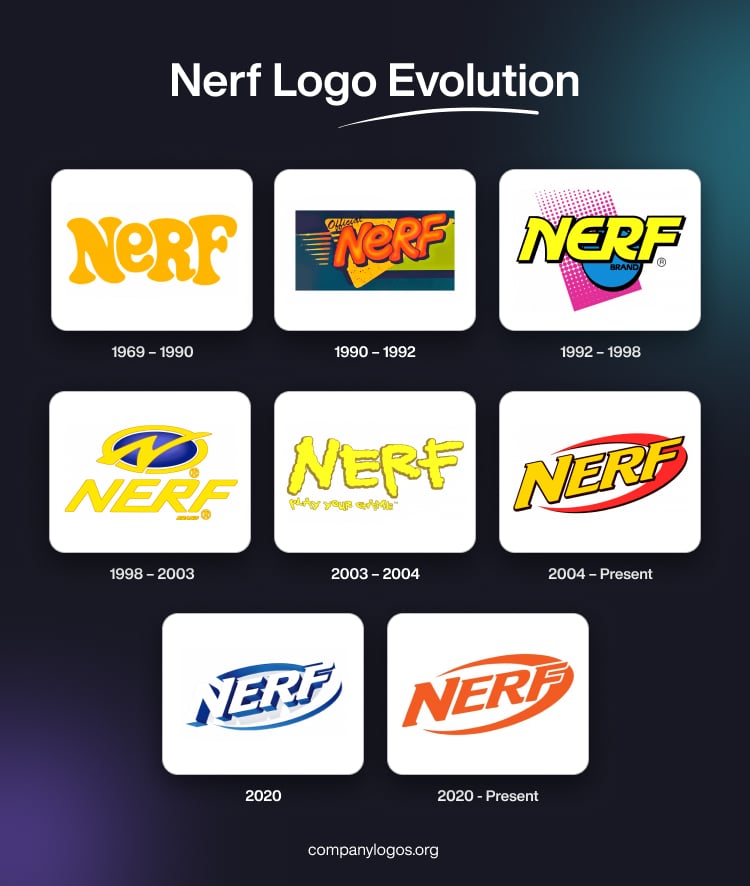
Nerf is a well-known toy brand from the USA, which is known for water guns and foam dart blasters. Founded by the Parker Brothers in 1969, the company is now owned by the Hasbro company. The initial journey of the brand started with producing indoor safe balls, but with time, it expanded to include ammunition made from polyurethane foam and weaponry made of foam. Nerf provides a wide range of products that emphasise safe, active play, innovation, and customisation.
The Nerf logo has undergone several changes since the brand’s inception in 1969. These changes reflect the brand’s evolution from a simple foam ball toy to a dynamic and sporty toy blaster brand. The article provides a detailed overview of the history and evolution of the Nerf logo, among other details, over the years.
The Genesis of the Nerf Logo (1969 – 1990)
The first Nerf logo was introduced with the brand’s launch in 1969 and coincided with the release of its initial product, a safe-to-use foam ball. This original logo featured the brand name in a predominantly yellow colour scheme with letters written in a fantasy, informal font. Notably, the letters “N”, “R”, and “F” were capitalised, while the “E” was in lowercase, which gave the logo a playful and childlike feel.
The design was simple, with wide lines, irregular glyphs, and rounded corners. It evoked the sense of a painting by a child rather than formal typography. This logo remained in use for about two decades and established Nerf’s identity as a fun and safe indoor toy brand.
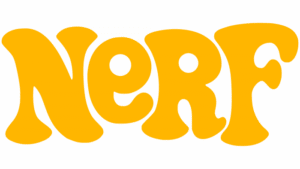
(1990 – 1992)
In 1990, Nerf updated its logo to a more mature but still informal design. The yellow letters remained but were complemented by darker shades and new colours such as red and green. Rectangular blocks appeared behind the Nerf wordmark, which added a sense of depth and complexity. The letters were less whimsical than before. They appeared more skilfully drawn but retained some hand-drawn qualities. This logo marked a transition from the purely playful to a slightly more structured identity, though it lasted only two years.
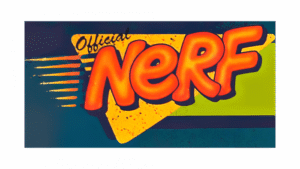
(1992 – 1998)
The 1992 redesign moved Nerf’s logo toward a more professional appearance. The font became more refined with creative serifs and curved diagonal bars on letters like “R” and “N”. A blue circle was added in the background to symbolise the original foam ball product. It appeared along with a purple shape with white dots, thereby adding dynamism and a sense of motion. The italicised font and diagonal elements suggested activity and energy, which aligned with Nerf’s growing product range beyond simple balls. The playful warmth of earlier logos diminished and was replaced by a more polished and dynamic look.
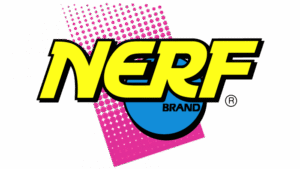
(1998 – 2003)
From 1998, Nerf embraced a sporty, professional logo design that resembled a sports team emblem. The serif font was dropped in favour of a standard italicised typography, and the letters “E” and “R” were joined at the bottom. An emblem was introduced to the logo above the brand name that featured a stylised “N” in front of a blue ellipse with a yellow border. This logo emphasised Nerf’s identity as a brand associated with action and competition rather than just children’s toys.
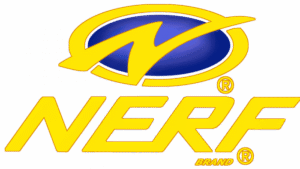
(2003 – 2004)
The 2003-2004 logo reverted to a childlike style where the letters appeared as if finger-painted by a child. It had irregular lines and a playful, informal feel that was similar to the original 1969 logo. Below the brand name was mentioned the words “Play Your Game” in a playful but smaller size. This design in vibrant yellow with a brown shadow was short-lived but highlighted Nerf’s roots in creativity and fun.
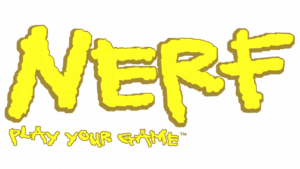
(2004 – Present)
In 2004, Nerf returned to a more mature and sporty logo. The yellow colour was made darker with a brownish tint and set against a white background. A red swoosh was added to the right of the brand name to emphasise speed and energy. This logo reflected Nerf’s focus on high-performance blasters and competitive play.
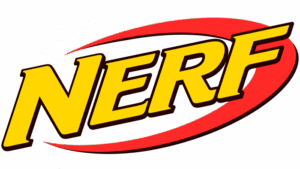
Alternative variant (2010–present)
In 2010, an alternative version of the above logo appeared with a blackish background, which added a more intense and bold visual identity. This logo remained in use for several years and became strongly associated with Nerf’s modern product line.
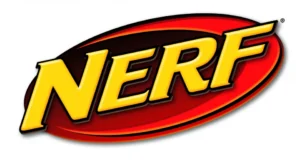
(2020)
In 2020, the logo variant featured a sleek 3D effect with the brand name rendered in white with varying shadows of blue. A gradient highlighted the 3D aspect of the logo to add depth and dimension. The surrounding arc and the letters cast subtle shadows and enhance the three-dimensional feel. This modern design aligned with Nerf’s contemporary image as a cutting-edge, dynamic toy brand while maintaining its sporty and energetic roots.
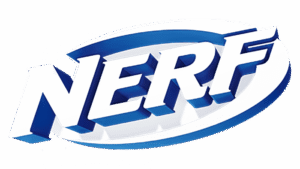
(2020 – Present)
The latest logo variant was also introduced in 2020, and it features the brand name in a similar style with an arc in an orange colour palette but in 2D.
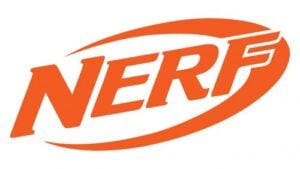
The Elements of the Nerf Logo
Font
The current Nerf logo employs the Letraset Crillee Italic typeface created by Dick Jones, Vince Whitlock, and Peter O’Donnell in 1980 – 1987. The typeface is bold with short triangular serifs.
Colour
The colour palette used in creating the Nerf logo has been quite consistent over the years. The primary colour has remained gold or yellow, but not of the same tint. The additional colours used were red, black, silver, blue, and light grey.
The History of Nerf
Nerf was founded in 1969 by Parker Brothers, and the company introduced the first official indoor ball made of polyurethane foam, known as the Nerf Ball. This 4-inch foam ball was designed to be safe for indoor play. The associated marketing slogans emphasised the ball could be thrown indoors “without breaking windows or damaging lamps”. Also, it can be used indoors without hurting old people or babies. The Nerf Ball was an instant hit, for it sold over four million units within just over a year.
Following the success of this ball, Nerf expanded its sports line in the early 1970s. It did so with products like the Nerfoop basketball game and the Nerf football in 1972, which became one of the company’s most popular items. By 1983, Nerf had introduced the Nerf Baseball and continued its focus on safe indoor sports toys.
Although Nerf was initially known for foam balls and sports toys, it ventured into foam projectile blasters in the late 1980s. The first Nerf blaster, the “Blast-a-Ball”, was released in 1989 and used a pump-action mechanism to shoot foam balls. This was followed by the “Blast-a-Matic” in 1990, which marked the beginning of Nerf’s now-iconic blaster line.
In 1991, Nerf introduced its first bow and arrow toy, thereby expanding its foam projectile range. The following year, in 1992, Nerf launched its first foam dart blaster, the Nerf Sharpshooter. This became a key milestone in the brand’s history and set the stage for future dart blaster innovations.
Throughout the 1990s and early 2000s, Nerf underwent several ownership and subsidiary changes. The parent company of Parker Brothers, Kenner Products, took over Nerf, and in 1987, Kenner was acquired by the Tonka Corporation. In 1991, Tonka was acquired by Hasbro, which brought Nerf under Hasbro’s umbrella. During this period, Nerf was managed by various subsidiaries, including OddzOn and Larami, before Hasbro took full control of the brand.
In 2004, Nerf introduced the N-Strike series, which featured the Unity Power System, allowing multiple blasters to be combined or fired simultaneously. This innovation introduced tactical rails and interchangeable parts, which greatly enhanced customisation and playability. Nerf continued to diversify its product lines and launched the “Rebelle” line in 2013. It was a sub-line targeted specifically at girls and reflected the brand’s efforts to broaden its appeal.
In 2015, Nerf launched the Rival line, which was aimed at an older demographic (14+). It featured blasters that fired small foam balls called “High Impact Rounds” at higher velocities than traditional darts. This marked Nerf’s move into more competitive and performance-oriented toy blasters. Nerf has continued to innovate with technology and product design. In 2016, it introduced the N-Strike Elite Terrascout RC, which was a remote-controlled blaster drone with live video and an 18-dart pin for remote bombardment. In 2017, the Accustrike series debuted, which focused on improved accuracy and performance.
In 2019, Nerf tapped into popular culture by releasing Fortnite-themed blasters. It merged the brand’s active play with the popular video game franchise. Most recently, in 2021, Nerf launched the Hyper system, which featured new Hyper rounds designed for maximum speed and capacity.
Interesting Facts About Nerf
- Nerf began its journey as the world’s first indoor ball in 1969. The ball was invented by Reyn Guyer, who created a 4-inch polyurethane foam ball that was safe for indoor play without damaging lamps or windows.
- The name “Nerf” comes from “nerf bars”, which are the protective foam-covered bars used in drag racing trucks to prevent damage during collisions.
- The first Nerf gun, called the “Blast-a-Ball”, was launched in 1989, that is, two decades after the debut of the Nerf ball. It was a pump-action blaster that shot foam balls.
- In 1992, Nerf released its first foam dart blaster, the Nerf Sharpshooter. It marked the beginning of the iconic foam dart blaster line that defines the brand today.
- Minnesota Vikings kicker Fred Cox invented the Nerf football in 1972, which quickly became one of Nerf’s most popular sports products.
- The brand’s early advertising famously included the slogan: “Throw it indoors; you can’t damage lamps or break windows. You can’t hurt babies or old people,” to emphasise safety and indoor fun.
- Nerf has expanded beyond balls and blasters to include a wide variety of foam-based toys. These include bows and arrows, slingshots, and even remote-controlled blaster drones.
- The Rival line, introduced in 2015, targets older players with high-impact foam rounds that shoot faster and farther than traditional darts. It reflects Nerf’s move toward more competitive play.
- Nerf products have appeared in popular TV shows like The Office, 30 Rock, Modern Family, and Chuck, thereby showing their cultural penetration beyond just toys.
- Celebrities like George Clooney have been known to playfully use Nerf products on set, with actors like Anna Kendrick and Ryan Gosling recounting Nerf-related antics during filming.
- Nerf designers test new prototypes in simulated indoor environments such as bedrooms, basements, and offices to ensure safety and performance. This highlights the brand’s commitment to ensuring realistic play experiences.
- Over the years, Nerf has sold enough foam darts to circle the Earth four times, thereby demonstrating the massive popularity and reach of the brand.
Finally
The Nerf logo and its various iterations show how the brand evolved from producing a simple indoor foam ball to becoming an internationally recognised name in active, foam-based toys and blasters. Each logo redesign reflects shifts in branding strategy, be it from playful and informal to sporty and professional.